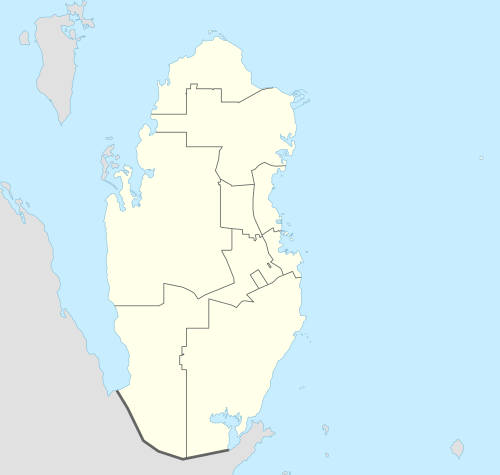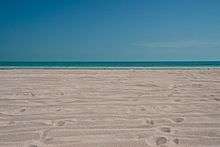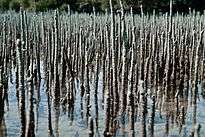Fuwayrit
| Fuwayrit فواريت | |
|---|---|
| Village | |
 Fuwayrit Fuwayrit | |
| Coordinates: QA 26°1′18″N 51°22′1″E / 26.02167°N 51.36694°ECoordinates: QA 26°1′18″N 51°22′1″E / 26.02167°N 51.36694°E | |
| Country | Qatar |
| Municipality | Ash Shamal |
Fuwayrit is a coastal village in Qatar, located in the municipality of Ash Shamal approximately 80 km north of the capital Doha.[1] It is an important site for Qatar's oil industry. Previously, it was one of the most important towns in the northern sector of Qatar. The Al Thani had settled in the town in the 19th century, prior to relocating to Al Bidda (presently Doha).
Geography
Together with Ras Laffan, Fuwayrit accommodates approximately 30% of all sea turtle nests in Qatar.[2] Fuwayrit Beach is reported as offering the best protection to turtle eggs anywhere in the country, with 14 nests being preserved in 2012.[3] Fuwayrit Beach operates as a bird-watching site.[4]
History
19th century
1828–1829 conflict

In 1828–1829, a conflict emerged between the inhabitants of Fuwayrit and Doha after natives of Fuwayrit robbed a family with close ties to the Al Thani family. A nephew of Thani bin Mohammed named Khalfan bin Khalfan inherited a large sum of money after his father, a wealthy tawash (pearl trader), died. Khalfan's mother gave Thani the inheritance to invest it on her son's behalf. When Khalfan became an adult, Thani distributed the money, which now amounted to a fortune, to Khalfan, and his son, Mohammed bin Thani.[5] Khalfan soon opened a business in Fuwayrit. Tensions arose between envious local residents and Khalfan, and this culminated in Khalfan being robbed of all his money.[6]
Having been robbed of his money, he appealed to Abdullah bin Ahmed Al Khalifa, a Bahraini representative stationed in Qatar, but he had little interest in Khalfan's protests because he was preoccupied with the recent death of his brother, Salman. A man named Ali bin Amr Al Attiyah was present during Khalfan's appeal and promised to help him on account of a tribal alliance. They went to Doha where they were successful in receiving volunteers from the Bani Malik, Al Soudan, and Al Suluta tribes.[6] The coalition forces departed from Doha and traveled to Fuwayrit via boat.
Upon hearing of the forces' departure, the people of Fuwayrit renounced their ill-gained wealth. After Thani bin Mohammed's death a few months after the end of the conflict, Khalfan and Mohammed relocated to Doha.[6]
Battle of Fuwayrit
The town was frequently visited and its affairs interfered with by the ruler of Bahrain, Mohammed bin Khalifa. In 1847, Isa bin Tarif, the chief of Al Bidda, became convinced that Mohammed wanted to bring the nearby town of Zubarah under his control in order to prevent future attacks on Bahrain from being launched from the coast of Qatar.[7]
The deposed ruler of Bahrain, Abdullah bin Ahmed bin Khalifa, lived in Qatar during this period. After garnering support from the Wahhabis of Najd, he threatened to occupy Bahrain. In addition to having support from the Wahhabis, Isa also pledged his allegiance to Abdullah. This prompted Mohammed bin Khalifa to write a letter to Captain William Lowe, captain of the East India Company's naval squadron, in November. Captain Lowe responded to the letter by requesting Mohammed to refrain from hostilities at sea, and warned that any vessels found being used for war would be seized. Mohammed retorted by blaming Isa and Abdullah for creating a warlike atmosphere. On 7 November 1847, Isa and his deputy jointly wrote to Samuel Hennel describing their suspicions of Mohammed's plan to invade the north-east coast of Qatar.[8]
Intent on defending the coast from Bahraini intervention, Isa and Mubarak bin Ahmed preemptively arrived in Fuwayrit with troops in the first week of November. Mohammed retorted by sending 7 small ships and 20 battils and advancing towards Fuwayrit by way of Zubarah. As the tensions worsened, the British dispatched several naval ships to blockade Al Bidda and wrote warning letters to Isa, Abdullah and Mohammed. Shortly after, Mohammed's military general Ali bin Khalifa landed on the coast of Al Khor with 500 Bahraini troops under his command. The Bahraini forces were accompanied by the governors of Al-Hasa and Qatif. The forces of Isa and Mubarak bin Ahmed numbered 600 troops.[9]
The decisive battle took place on 17 November 1847 near Fuwayrit. Isa's forces were defeated after he and eighty of his men were killed. After proclaiming victory, Mohammed sent his warships to attack and demolish Al Bidda, and relocated most of its inhabitants to Bahrain. Afterwards, Abdullah fled to Iran, while his son Mubarak fled to Najd with 200 supporters. Mohammed allowed 250 prisoners of war to settle on Kish Island.[10]
Late 19th century
In November 1879, there was a mass exodus of members of the Bu Kuwara tribe from Doha to Fuwayrit.[11] The cause of the migration was tensions between the tribe and emir Jassim bin Mohammed, and was said to have been instigated by the Bahraini sheikh. In 1881, they were joined by members of the Al Nuaim tribe.[12]
An 1890 British account records Fuwayrit as "A small walled town with several towers, 12 miles northwest of Ras Laffan, standing on a small khor; it has some white sand-hills immediately to the northward of it. The people of these towns are of the Al Bu Kuwara [Kuwari] tribe. At about 4 miles north of this place, a small village with several towers has been established by people from Wakra, and called Al Ghariyah. A small village with several towers, called ar Riyat, now stands about 2 miles north of Fuwairit and just to northward of the sand hills."[13]
20th century

Fuwayrit was described as such in J.G. Lorimer's Gazetteer of the Persian Gulf in the early 20th century:
"A village on the east side of Qatar promontory about 10 miles from its northern extremity. Immediately to the north of it is a hill called Jabal-al-Fuwairat, separating it from the site of the now deserted village of Ghariyah, which is also on the coast; according to another account, however, the Jabal is merely a vertical cliff 30 feet high, against the foot of which the sea breaks. The village is surrounded by towers, but it is not continuously walled and there are no gates. The house upon the circumference of the village are substantially built of stone and mud. The population of Fuwairat consists of about 100 houses of the Al Bu Kuwarah [Kuwari] tribe and 50 of Kibisah [Qubaisi] : these communities are divded from one another by a well marked street and form a southern and northern quarter respectively. The people live chiefly by pearl diving, but they also own some 20 horses, 100 camels, 60 donkeys and 80 cattle. About 35 pearl boats [manned by 420 men], 9 other sea-going vessels, and 12 fishing boats belong to the place. There are no shops. Indifferent water is obtained from the Zarka well, 1 mile west of the village, and good water from the wells of Filihah, and Ain Sinan distant 2 and 4 miles respecitvely to the south-west."[14]
Tourism
Fuwayrit is known for its beach located on the outskirts of the village.[1]
References
- 1 2 "Beaches". Qatar Tourism Authority. Retrieved 25 October 2015.
- ↑ "Nature's gift to Fuwairit, turtles". JustHere Qatar. 25 May 2014. Retrieved 14 January 2016.
- ↑ "Hawksbill finds safe haven in Qatar shores". The Peninsula. 11 July 2012. Retrieved 14 January 2016.
- ↑ "Sailiyah becomes a graveyard for birds". The Peninsula. 12 January 2015. Retrieved 14 January 2016.
- ↑ Al-Attiyah, Hessa (2013). Reviving the Local Dialect in Qatar: An Issue of Linguistic Concern or Identity Politics?. Arab Center for Research and Policy Studies. p. 14.
- 1 2 3 Al-Attiyah, p. 15
- ↑ Rahman, Habibur (2006). The Emergence Of Qatar. Routledge. p. 95. ISBN 978-0710312136.
- ↑ Habibur Rahman, p. 96
- ↑ Habibur Rahman, p. 97
- ↑ Habibur Rahman, p. 98
- ↑ "'Gazetteer of the Persian Gulf. Vol I. Historical. Part IA & IB. J G Lorimer. 1915' [804] (959/1782)". Qatar Digital Library. Retrieved 6 August 2015.
- ↑ "'Gazetteer of the Persian Gulf. Vol I. Historical. Part IA & IB. J G Lorimer. 1915' [805] (960/1782)". Qatar Digital Library. Retrieved 6 August 2015.
- ↑ The Persian Gulf pilot: comprising the Persian Gulf, Gulf of Omán; and Makran coast. Great Britain: Hydrographic Dept. 1890. p. 126–127.
- ↑ "'Gazetteer of Arabia Vol. I' [632] (675/1050)". Qatar Digital Library. Retrieved 28 July 2015. This article incorporates text from this source, which is in the public domain.